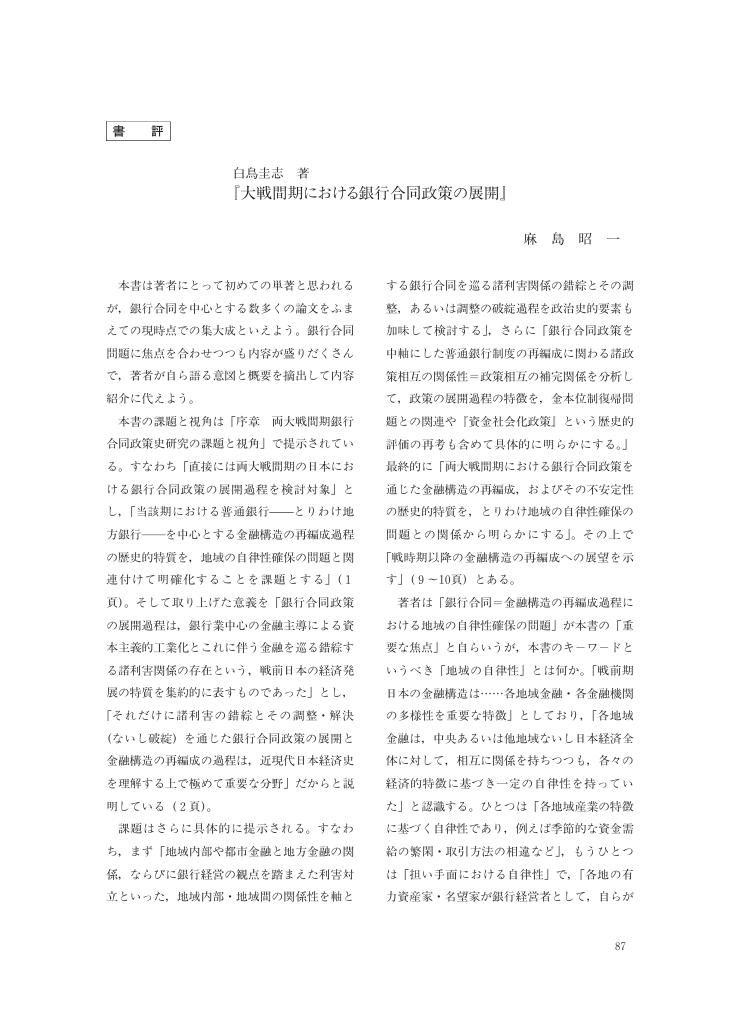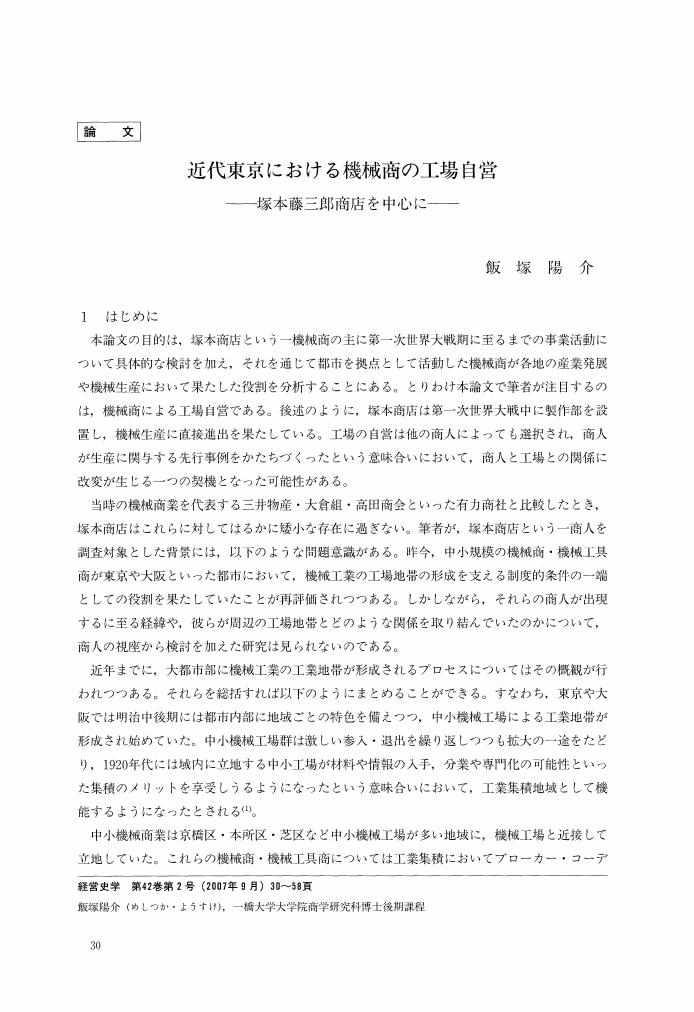1 0 0 0 OA 1950年代前半における復興金融金庫貸付債権と日本開発銀行による管理回収
- 著者
- 宮崎 忠恒
- 出版者
- Business History Society of Japan
- 雑誌
- 経営史学 (ISSN:03869113)
- 巻号頁・発行日
- vol.43, no.1, pp.1_56-1_86, 2008 (Released:2011-10-18)
This paper focuses on problem about management and collection of the loans by government financial institution. Specifically, this article examines how the Japan Development Bank (JDB, Nihon Kaihatsu Ginkou) managed and collected loans that taken over from the Reconstruction Finance Bank (RFB, Fukkou Kinyuu Kinko) in the first half of the 1950s.The RFB, which played an important role in reconstruction of Japanese economy after World War II by supplying industrial funds, was disbanded in January 1952. Its vast uncollected loans were taken over by the JDB. Since then, the JDB managed and collected those loans.Among those loans, loans to coal mining industry were the biggest one measured by outstanding loans and amount of collection. In addition, collection rate of loans to that industry was lowest at end of March 1956.In the first half of 1950s, for the JDB, collected money of those loans was important resource on its own activities. Therefore, the JDB selected to mitigate collection from coal mining industry on its own managerial point of view. Around the same time, the Government, whose priority was put on cutting price of coal, made several plans that included across-the-board mitigation of collection from that industry. However, those plans were not brought into effect. If political and unselective mitigation carried out along those plans, collection rate of loans to that industry was far lower.Previous studies about the JDB put importance on its independence at lending activities that is one aspect of the financial institution. However, the result of this paper shows that its subjectivity at managing and collecting activities that is another aspect also should be emphasized.
1 0 0 0 OA 書評
- 出版者
- 経営史学会
- 雑誌
- 経営史学 (ISSN:03869113)
- 巻号頁・発行日
- vol.43, no.1, pp.1_87-1_96, 2008 (Released:2011-10-18)
- 被引用文献数
- 1 1
1 0 0 0 OA わが国医薬品業界における先駆的販売組織
- 著者
- 神保 充弘
- 出版者
- Business History Society of Japan
- 雑誌
- 経営史学 (ISSN:03869113)
- 巻号頁・発行日
- vol.43, no.2, pp.2_3-2_29, 2008 (Released:2012-02-11)
- 被引用文献数
- 1 2
The purpose of this article is to analyze how the sales organization—Hoshi Pharmaceutical Company—was established and developed in the prewar Japanese pharmaceutical industry. An analysis of this achievement is very useful for explaining the process by which the distribution “keiretsu” was formed in the Japanese pharmaceutical industry.It was during the period of high economic growth that the distribution keiretsu was introduced in the Japanese industry in earnest. However, the distribution keiretsu had already been introduced by some pioneer companies before the outbreak of the Pacific War. Some of the companies belonged to the pharmaceutical industry.We consider Taisho Pharmaceutical Co., Ltd. and Takeda Pharmaceutical Co., Ltd. as the pioneer companies that introduced the distribution keiretsu in the prewar Japanese pharmaceutical industry. However, it is necessary to study another key company—Hoshi Pharmaceutical Company—in addition to these two companies when we attempt to clarify the origin of the distribution keiretsu in the industry. This is because it is understood that Hoshi Pharmaceutical Company was the pioneer that first introduced the distribution keiretsu in the industry.This article analyzes the period from 1906 to around 1923-1924, because during this period, the sales organization of Hoshi Pharmaceutical Company operated to a large extent and functioned most effectively.
1 0 0 0 OA 建設業・製造業の技術革新と高卒者の役割
- 著者
- 大場 隆広
- 出版者
- Business History Society of Japan
- 雑誌
- 経営史学 (ISSN:03869113)
- 巻号頁・発行日
- vol.43, no.2, pp.2_30-2_56, 2008 (Released:2012-02-11)
The purpose of this article is to clarify roles of high school graduate workers in Japan from the 1950s to the early 1960s. In particular, I address the following questions: Did high school graduate workers play the same roles as junior high school graduate workers in factories? And, if they played different roles, how were their roles different from those of junior high school graduate workers?In post-war Japan, high school enrollment ratio substantially went up, which led to the increase of high school graduate workers. High school graduates had worked as engineers and white-collars until the 1950s, while junior high school graduates had worked as skilled blue-collar workers. As a result of the increase of high school graduates, they came to be employed as blue-collar workers. The primary goal of this article is to reveal the impact of high school graduate workers on the production and working systems.To make clear the impact, first, I examine questionnaire surveys and other documents. From these surveys and documents, I derive two hypotheses: One hypothesis is that high school graduate workers were employed as substitutions of junior high school graduate workers and thus simply took same roles as junior high school graduate workers. The other hypothesis is that high school graduates contributed to the development of production systems as workers suitable for dealing with new technology, equipment or machines and thus had different roles from junior high school graduate workers.Then, I confirm those hypotheses using the data and reports by the University of Tokyo on three major companies; Hazama-gumi, Ishikawajima Heavy Industries, and Toyo Koatsu Kogyo. All investigations and reports for this study were made in the 1950s or the early 1960s. After examining these data and reports, I statistically analyze whether high school graduate workers had a positive impact on factory's production by using quantitative data. Finally, I make a concluding statement on roles of high school graduate workers and their impact on production systems.
1 0 0 0 OA 灘酒造家による商標の統一化と販売戦略の変化
- 著者
- 大島 朋剛
- 出版者
- Business History Society of Japan
- 雑誌
- 経営史学 (ISSN:03869113)
- 巻号頁・発行日
- vol.43, no.2, pp.2_57-2_88, 2008 (Released:2012-02-11)
- 被引用文献数
- 1 1
This paper clarifies the structure of the management development in prewar days of a large-scale brewer in Nada, Hyogo Prefecture, observing the source of the profit in the distribution process. Tatsuuma-Honke in Nishinomiya is adopted as an example. The way that should be and the change of the complicated Japanese sake distribution process are considered by an analysis which combined its sales market, sales strategy, and individual management. As a result, the following points were solved in this paper.First, it is confirmed that in the mid-1920s Tatsuuma-Honke established even in Tokyo the relation of maker predominance which was previously being developed in a local market. Although the company did not necessarily persist in its share reservation in the Tokyo market, without being bound by the monopoly right of the brand which remained among each wholesaler, it was meaningful to enable sales with the “Hakushika” brand which it specified itself.In process of the trademark establishment, the production of self-made sake increased and the raising of the bottom level of the quality was achieved. As a result, in Tatsuuma-Honke, it became possible to use a sales strategy which was further conscious of the brand's bottling sales. However, it was more important for Tatsuuma-Honke to internalize the structure which combined a sales method — undiluted sake dealing in a tun unit— called “Oka-Uri” with the opposite character of bottling, and carries out the hedge of the unsold risk. This also meant the possibility that the purchase of the undiluted sake from a minor-scale brewer would be demoted to the 2nd buffer for a large-scale brewer. This indication adds new knowledge to a simple understanding that the former specialized in Oke-Uri and the latter was based on sales of brand sake, as shown by the conventional history of research.The high profitability in the distribution process as the above-mentioned result relatively stabilized the brewing management of Tatsuuma-Honke in the depression of the 1920s. Such a case was just a pattern of the development which preceded the large-scale management in the prewar-days term of the Nada brewing industry.
1 0 0 0 OA 書評
- 出版者
- Business History Society of Japan
- 雑誌
- 経営史学 (ISSN:03869113)
- 巻号頁・発行日
- vol.43, no.2, pp.2_89-2_97, 2008 (Released:2012-02-11)
1 0 0 0 OA 戦前戦時期松下の分社経営
- 著者
- 平本 厚
- 出版者
- 経営史学会
- 雑誌
- 経営史学 (ISSN:03869113)
- 巻号頁・発行日
- vol.42, no.4, pp.3-32, 2008-03-25 (Released:2010-05-18)
- 参考文献数
- 78
1 0 0 0 OA 鉄鋼業における職務給制度導入と人事労務管理の合理化 八幡製鉄を事例として
- 著者
- 杉山 裕
- 出版者
- 経営史学会
- 雑誌
- 経営史学 (ISSN:03869113)
- 巻号頁・発行日
- vol.42, no.4, pp.33-57, 2008-03-25 (Released:2010-05-18)
- 参考文献数
- 93
1 0 0 0 OA 地域経済活性化への経営史学の貢献
1 0 0 0 OA 国策会社の経営史 台湾拓殖における国策性と営利性
- 著者
- 久保 文克
- 出版者
- 経営史学会
- 雑誌
- 経営史学 (ISSN:03869113)
- 巻号頁・発行日
- vol.42, no.4, pp.68-74, 2008-03-25 (Released:2010-05-18)
1 0 0 0 OA 町 (街) おこし その展望と課題
- 著者
- 水口 和寿
- 出版者
- 経営史学会
- 雑誌
- 経営史学 (ISSN:03869113)
- 巻号頁・発行日
- vol.42, no.4, pp.74-80, 2008-03-25 (Released:2010-05-18)
1 0 0 0 OA 東アジア企業のグローバル競争力構造 競争力要因と競合・分業構造分析
- 著者
- 塩地 洋
- 出版者
- 経営史学会
- 雑誌
- 経営史学 (ISSN:03869113)
- 巻号頁・発行日
- vol.42, no.4, pp.80-86, 2008-03-25 (Released:2010-05-18)
1 0 0 0 OA 高度成長の展開と経営構造の変化 経営史からみた大衆消費社会の形成
- 著者
- 石井 晋
- 出版者
- 経営史学会
- 雑誌
- 経営史学 (ISSN:03869113)
- 巻号頁・発行日
- vol.42, no.4, pp.86-93, 2008-03-25 (Released:2010-05-18)
1 0 0 0 OA 地域再生と企業者活動
- 著者
- 井藤 正信
- 出版者
- 経営史学会
- 雑誌
- 経営史学 (ISSN:03869113)
- 巻号頁・発行日
- vol.42, no.4, pp.93-102, 2008-03-25 (Released:2010-05-18)
1 0 0 0 OA 近代東京における機械商の工場自営 -塚本藤三郎商店を中心に-
- 著者
- 飯塚 陽介
- 出版者
- 経営史学会
- 雑誌
- 経営史学 (ISSN:03869113)
- 巻号頁・発行日
- vol.42, no.2, pp.30-58, 2007-09-25 (Released:2010-03-19)
- 参考文献数
- 95
1 0 0 0 OA 戦後の日本企業の技術選択と技術発展 東洋紡績の合成繊維への進出を中心として
1 0 0 0 OA 明治前期製糸業における商標の確立と行政による保護 群馬県と福島県の制度分析と比較
- 著者
- 谷山 英祐
- 出版者
- 経営史学会
- 雑誌
- 経営史学 (ISSN:03869113)
- 巻号頁・発行日
- vol.42, no.3, pp.68-91, 2007-12-25 (Released:2010-03-19)
- 参考文献数
- 125
1 0 0 0 OA めざせ文化資源館! -渋沢栄一記念財団付属渋沢史料館, 実業史研究情報センターの新展開-
- 著者
- 井上 潤 小出 いずみ
- 出版者
- 経営史学会
- 雑誌
- 経営史学 (ISSN:03869113)
- 巻号頁・発行日
- vol.41, no.3, pp.57-65, 2006-12-25 (Released:2009-11-06)
1 0 0 0 OA 国際競争力の経営史
- 著者
- 湯沢 威
- 出版者
- 経営史学会
- 雑誌
- 経営史学 (ISSN:03869113)
- 巻号頁・発行日
- vol.41, no.4, pp.27-34, 2007-03-25 (Released:2010-02-25)















